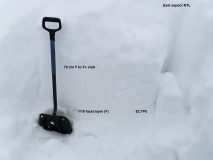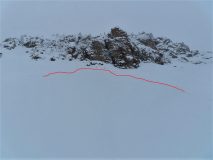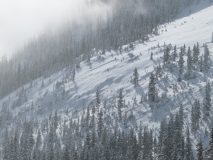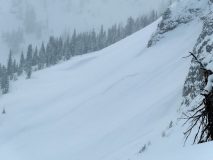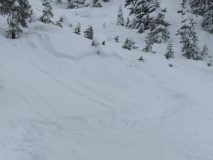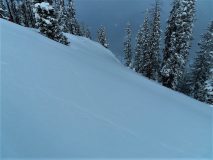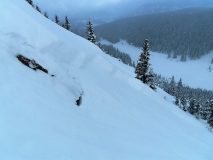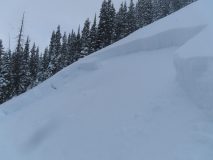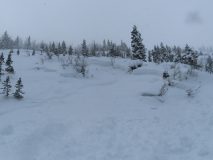Date of Observation: 01/25/2021
Name: Jack Caprio and Zach Guy
Zone: Northwest Mountains
Location: Ruby/Dyke area, then Anthracites
Aspect: North, North East, East, South East
Elevation: 10,000-11,500
Avalanches: We remotely or sympathetically triggered 6 D1 to D1.5 persistent slab avalanches on east facing terrain near and below treeline.
1 remotely triggered D1 on an east facing near treeline slope off Ruby Peak. This avalanche was triggered from about 200 vertical feet below. The crown was 18 inches of recent storm snow on facets ( 1/19 interface).
In the Anthracites, we continued to find instabilities. We remotely triggered one D1.5 soft slab avalanche which then sympathetically triggered 4 more small avalanches (D1 to D1.5) on the same terrain feature. All of these failed on facets just below the 1/19 interface with the crowns ranging from 24-30 inches of soft (F hard) storm snow. We also ski triggered a similar slide on a small rollover.
We observed a handful of natural soft slab avalanches that likely ran on Saturday, D1 to D1.5: 2 on east facing terrain below treeline, 2 on southeast facing terrain below treeline, and 1 on a southeast aspect near treeline.
Weather: Overcast skies with moderate snowfall all morning (S2) near Lake Irwin. We made our way over to the anthracites around 11:00 am where we were welcomed with broken skies and the occasional pulse of very light snowfall (S-1).
Snowpack: We generally found about 18-30 inches of recent F to F+ hard storm snow sitting on top of the 1/19 interface. This interface consisted of a thin, weak MF crust capping facets on southeast aspects and facets or facets below a thin wind crust on due east.
On east facing terrain below Ruby Peak, several collapses and an easily propagating extended column test (ECTP5) turned us away from some steeper and more consequentail terrain options. A couple of steps after the snowpit test, we remotely triggered a D1 soft slab from 200 vertical feet below the slope.
At the Anthracites, we took our first run on a north facing, below treeline slope. We did not observe any signs of instabilities aside from sluffing and a small pocket on a rollover. Stepping off the skin track near ridgeline, we observed several rumbling collapses on southeast, east, and flat slopes, along with shooting cracks. On our second run, traveled near some open, east facing terrain that had seen more wind loading, and produced a mess of avalanches from one remote trigger 50 feet from steep terrain
6 remotely/ sympathetically triggered persistent slab avalanches failing on the 1/19 interface continue to prove that this snowpack is setup for failure. In most snow-favored areas of our forecast zone, especially on leeward terrain features, we continue to find a grim persistent slab structure that is only in its infancy of causing problems.
Photos:
- Easy propagating results on the 1/19 interface
- Remotely triggered persistent slab from 200 feet away
- Natural D1.5 slab in East Bowl of Anthracites, likely ran 1/23
- Natural D1 slab SE aspect BTL. Anthra
- Small pocket triggered on a north aspect BTL
- Shooting cracks spanning the whole slope. East aspect NTL
- Remotely triggered from 50 feet away, East BTL
- Sympathetic release: East BTL
- Sympathetic release: East BTL




